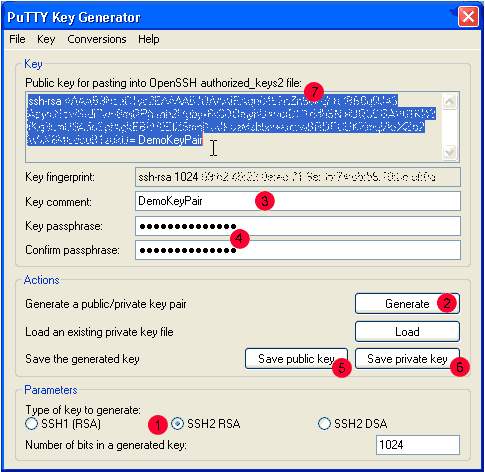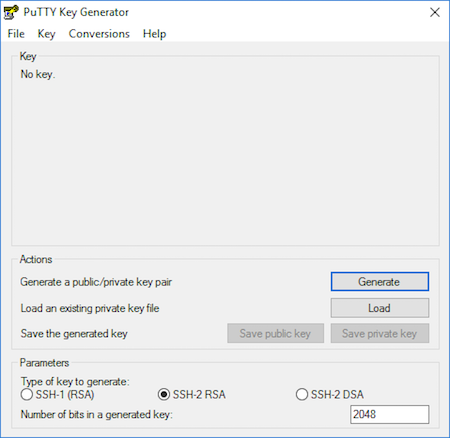Windows Generate Ssh Public Key Putty
Generate RSA keys with SSH by using PuTTYgen
One effective way of securing SSH access to your cloud server is to usea public-private key pair. This means that a public key is placed onthe server and a private key is placed on your local workstation.Using a key pair makes it impossible for someone to log in by using justa password, as long as you set up SSH to deny password-basedauthentication.
Pageant is a PuTTY authentication agent. It holds your private keys in memory so that you can use them whenever you are connecting to a server. It eliminates the need to explicitly specify the relevant key to each Linux user account if you use more th. With both Tectia SSH and OpenSSH servers, access to an account is granted by adding the public key to a /.ssh/authorizedkeys file on the server. To install the public key, Log into the server, edit the authorizedkeys file with your favorite editor, and cut-and-paste the public key output by the above command to the authorizedkeys file. Generate keys. In Windows, use PuTTYgen to generate your public and private keys. If needed, download PuTTYgen from the PuTTY download page. (PuTTYgen might have been installed previously with PuTTY or WinSCP.) Launch the program, and then click the Generate button.
This guide describes how to generate and use a private/public key pair to log in to a remote system with SSH using PuTTY.PuTTY is an SSH client that is available for Windows and Linux (although it is more common on Windows systems). 2 Generate a private and public key pair: Go to the Windows Start menu - All Programs - PuTTY and open PuTTYgen; Click the 'Generate' button and PuTTYgen will ask you to make some random movement with your mouse until it has enough random data to generate a secure key for you; Click the 'Save private key' button and save the resulting file. How to Generate SSH Keys on PuTTY. SSH keys are one of the most secure SSH authentication options. It is definitely more secure than the usual SSH password authentication. Therefore, it is highly recommended to use SSH Key authentication method for connections to your servers.
This article provides steps for generating RSA keys by using PuTTYgen onWindows for secure SSH authentication with OpenSSH.
Generate keys
In Windows, use PuTTYgen to generate your public and private keys.
- If needed, download PuTTYgen from the PuTTY download page.(PuTTYgen might have been installed previously with PuTTY or WinSCP.)
- Launch the program, and then click the Generate button.The program generates the keys for you.
- Enter a unique key passphrase in the Key passphrase andConfirm passphrase fields.For additional information about using passphrases,see Log in with a SSH Private Key on Windows.
- Save the public and private keys by clicking the Save public keyand Save private key buttons.
- From the Public key for pasting into OpenSSH authorized_keys filefield at the top of the window, copy all the text (starting with ssh-rsa)to your clipboard by pressing Ctrl-C.You need this key available on your clipboard to paste eitherinto the public key tool in the Control Panel or directly into theauthorized keys on your cloud server.
Use the key pair
You can use the RSA key pair in the following ways.
Specify your SSH key when creating a new cloud server
Ssh Public Key File

When you create a cloud server, you can assign a public key from the list of keys.If your key is not already in the list, you may add it, and then assign it.
Add a new public key to the list
- Under Advanced Options on the Create Server page, click Manage SSHKeys.
- Select public key for the cloud server from the SSH Keys listand click Add Public Key.
- Enter the key name, select the region, and paste the entire publickey into the Public Key field. Then click Add Public Key.
- Go back to the Create Server page, and confirm that your key is listedin the SSH Key list.
Assign a public key
- Under Advanced Options on the Create Server page, select the publickey you want to use from the SSH key drop-down menu.
- When you are done specifying the all the other details for the server,click Create Server.
Assign your SSH Key to an existing cloud server
To make use of your newly generated RSA key pair, you must tell PuTTY touse it when connecting to your cloud server.
To edit the file (or create it), run the following command on the cloud server:
Paste the text onto its own line in the file.
You must have the key available in your clipboard to paste it. The key and itsassociated text (the ssh-rsa identified at the start and the comment at the end)must be on one line in the file. If the text is word-wrapped onto multiple linesan error might occur when connecting.
If you created the authorized_keys file, change its permissionsafter you’re done editing it by running the following command:
Open PuTTY, and go to the SSH > Auth section.
Browse to the location of the key file, and load the private key.
Go to the Session page, and save the session. This saves the configurationso that PuTTY uses the key every time that you connect to your cloudserver.
After you save your session, your key is loaded automatically when youconnect to your server.
Related article
Experience what Rackspace has to offer.
©2020 Rackspace US, Inc.
Except where otherwise noted, content on this site is licensed under a Creative Commons Attribution-NonCommercial-NoDerivs 3.0 Unported License
-->To use an open SSH connection from your development machine to the server VM in your Azure Stack Hub instance that hosts your web app, you might need to create a Secure Shell (SSH) public and private key pair.
In this article, you create your keys and then use them to connect to your server. You can use an SSH client to get a bash prompt on the Linux server or use a Secure FTP (SFTP) client to move files to and from the server.
Create an SSH public key on Windows
In this section, you use PuTTY Key Generator to create a public SSH key and private key pair to use when you create a secure connection to Linux machines in your Azure Stack Hub instance. PuTTY is a free terminal emulator that can allow you to connect to a server via SSH and Telnet.
Open PuTTY Key Generator.
Under Parameters, select RSA.
In the Number of bits in a generated key box, enter 2048.
Select Generate.
In the Key area, generate some random characters by moving the cursor over the blank area.
Enter a Key passphrase and confirm it in the Confirm passphrase box. Note your passphrase for later use.
Select Save public key, and save it to a location where you can access it.
Select Save private key, and save it to a location where you can access it. Remember that it belongs with the public key.
Your public key is stored in the text file you saved. The text looks like the following:
When an application requests the key, you copy and paste the entire contents of the text file.
Connect with SSH by using PuTTY
When you install PuTTY, you have both PuTTY Key Generator and an SSH client. In this section, you open the SSH client, PuTTY, and configure your connection values and SSH key. If you're on the same network as your Azure Stack Hub instance, you connect to your VM.

Before you connect, you will need:
- PuTTY
- The IP address and username for the Linux machine in your Azure Stack Hub instance that uses an SSH public key as the Authentication type.
- Port 22 to be open for the machine.
- The public SSH key that you used when you created the machine.
- The client machine that runs PuTTY to be on the same network as your Azure Stack Hub instance.
Generate Ssh Public Key Putty
Open PuTTY.
In the Host Name (or IP address) box, enter the username and public IP address of the machine (for example, username@192.XXX.XXX.XX).
Validate that the Port is 22 and the Connection type is SSH.
In the Category tree, expand SSH and Auth.
Next to the Private key file for authentication box, select Browse, and then search for the private key file (<filename>.ppk) of your public and private key pair.
In the Category tree, select Session.
Under Saved Sessions, enter a name for the session, and then select Save.
In the Saved Sessions list, select the name of your session, and then select Load.
Select Open. The SSH session opens.
Windows Generate Ssh Public Key Putty Key
Connect with SFTP with FileZilla
To move files to and from your Linux machine, you can use FileZilla, an FTP client that supports Secure FTP (SFTP). FileZilla runs on Windows 10, Linux, and macOS. The FileZilla client supports FTP, FTP over TLS (FTPS), and SFTP. It is open-source software that's distributed free of charge under the terms of the GNU General Public License.
Set your connection
Putty Create Ssh Key
Download and install FileZilla.
Open FileZilla.
Select File > Site Manager.
In the Protocol drop-down list, select SFTP - SSH File Transfer Protocol.
In the Host box, enter the public IP address for your machine.
In the Logon Type box, select Normal.
Enter your username and password.
Select OK.
Select Edit > Settings.
In the Select page tree, expand Connection, and then select SFTP. Athentech perfectly clear 2.2.0.
Select Add key file, and then enter your private key file (for example, <filename>.ppk).
Select OK.
Open your connection
- Open FileZilla.
- Select File > Site Manager.
- Select the name of your site, and then select Connect.
Putty Generate Key
Next steps
Learn how to Set up a development environment in Azure Stack Hub.